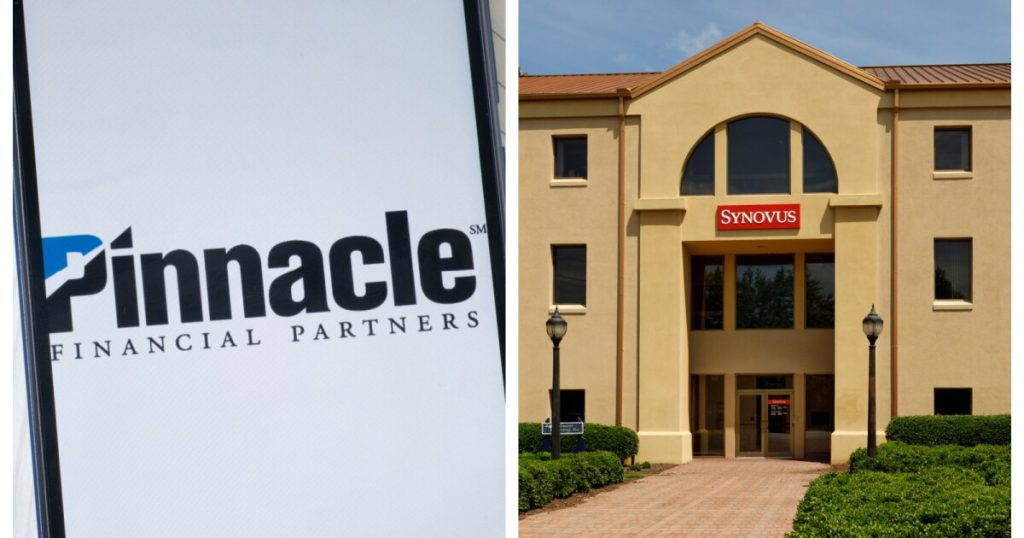The proposed merger between Pinnacle Financial Partners and
Shares of each bank, which fell on the news of
Investors’ reaction appears to be tied partly to what they perceive to be cultural differences between the two banks, including an incentive-based compensation model at Pinnacle, and the change in direction for the banks, both of which have been
In response to the deal news, some analysts downgraded the two banks. David Chiaverini, an analyst at Jefferies, reduced his rating on Pinnacle, while Timur Braziler, an analyst at Wells Fargo Securities, did the same for
In a research note, Braziler said he expects “dilution to Pinnacle’s superior growth rate,” as a result of the transaction doubling the bank’s size and the formation of a new management team.
On Friday, Braziler told American Banker that the key takeaway is that mergers of equals “are still very much out of favor.”
“I can’t even say the conversations with investors have been negative,” Braziler said. “They’ve been overwhelmingly negative, and very few conversations spun in a positive direction.”
Terry Turner, Pinnacle’s co-founder and CEO, was undeterred by the market’s reaction.
“It’s an unfortunate thing, but it doesn’t change our excitement for what the earnings case is, what the shareholder return case is,” Turner told American Banker on Friday. “When we combine these companies, we’re going to be the best at compounding revenue and earnings in the peer group.”
The companies expect the transaction to be roughly 21% accretive to the combined bank’s estimated operating earnings per share in 2027, with a tangible book value per share earn-back period of 2.6 years.
The proposed union of Nashville-based Pinnacle, which was founded 25 years ago with
It would create one of the largest banks in the Southeast. The combined entity would operate under the Pinnacle name and brand.
The company’s board would draw heavily from both banks. Eight directors would join from Pinnacle’s board, and seven would come from
As part of the deal, the $54.8 billion-asset Pinnacle would relocate its headquarters to Atlanta. Its banking subsidiary, Pinnacle Bank, would continue to be based in Nashville.
Braziler of Wells Fargo Securities said there’s a meaningful amount of risk involved in shaking up business models that are successful, such as Pinnacle’s.
“The risk here is that their secret sauce is at risk,” Braziler said. “Can a company that’s twice the size grow higher revenues at the same pace? Maybe they can, but why put a model that’s already doing that at risk?”
Mergers of equals are difficult to pull off without hitting bumps in the road. The most notable and recent example is Charlotte, North Carolina-based Truist Financial, which is the product of a merger between BB&T and SunTrust Banks, two dominant Southeast banks of similar size that came together in late 2019.
The $537.1 billion-asset company didn’t have to deal with crossing the $100 billion-asset threshold — both banks were well above that size when they merged — but it has struggled to achieve certain goals related to profitability and shareholder returns.
In the deal announced Thursday,
Turner argued against the idea that recent mergers of equals have struggled, saying that certain such unions have been successful, including the 2024 deal between JPMorganChase and Bank One. He said Pinnacle and
“I’ve actually seen some CEOs say, ‘Our cultures are identical’ — which couldn’t possibly be the case,” Turner said. “Every bank’s got variances in their culture.”
“But what I think is part of the appeal about this, and the reason we want to do it, is: Our cultures are remarkably similar.”
As for the regulatory burden of crossing the $100-billion-asset threshold, Turner said the new Pinnacle Bank is ready.
“It never made sense to me to say I’m going to slow my company down — I’m going to earn less — so that I don’t have to take on increased regulatory risk,” he said. “Our combined company is well prepared to do it.”
Yet there are risks in jumping quickly over that threshold. Flagstar Financial, formerly known as New York Community Bancorp, crossed the $100-billion mark in early 2023 after it completed two back-to-back acquisitions.
By early 2024, the Long Island-based company was
Blair and Turner addressed the souring market reaction Thursday evening during a post-deal announcement conference call with analysts. Blair said the initial response may have reflected some investors’ surprise about the proposed combination of the two banks.
Turner said that “nobody has had a chance to hear the story” about the combined company.
He also said: “Nobody has had a chance to see what the power of the combined organization is.”
Jefferies analyst Chiaverini said that the deal size could challenge Pinnacle’s talent acquisition strategy, “which has field growth through organic recruiting” from bigger banks.
“The deal with
In addition, the combined company’s enhanced deposit market share in the Southeast “could narrow the pool of larger institutions from which to recruit talent,” he wrote. “We believe this dynamic, combined with the law of large numbers, could begin to slow the company’s traditional high-growth model.”
As for whether the market’s negative response may make other regional banks reconsider near-term deals, especially mergers of equals, Braziler said it depends.
“The good news is the likelihood of large [mergers of equals] is going to be pretty small, and the vast majority of these transactions will be among the smaller banks,” he said.

